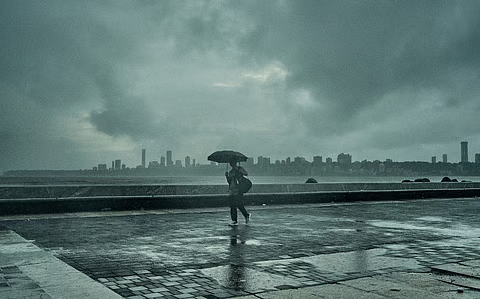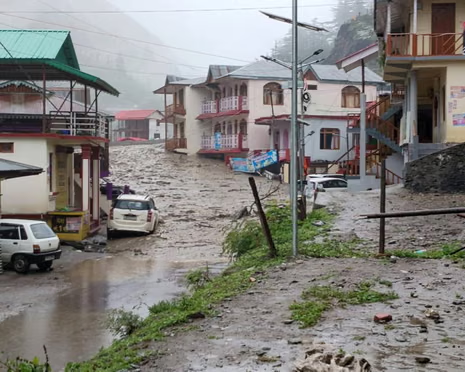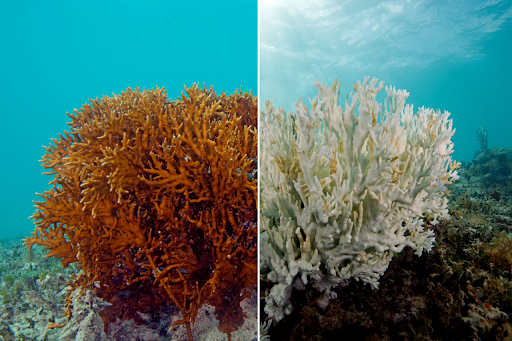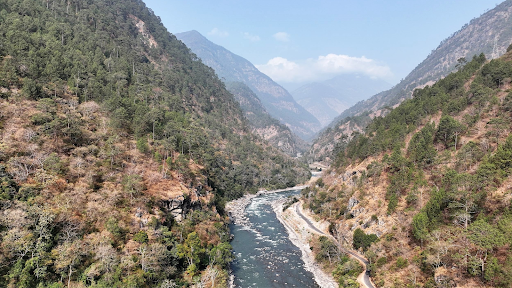Description

Disclaimer: Copyright infringement not intended.
Context: In July, the Odisha government approved a proposal to plant 19 lakh palm trees to ward against the problem of deaths due to lightning strikes.
Details
What is lightning?
- Lightning is a giant spark of electricity in the atmosphere between clouds, the air, or the ground.
Formation
- Lightning can occur between opposite charges within the thunderstorm cloud (Intra Cloud Lightning) or between opposite charges in the cloud and on the ground (Cloud-To-Ground Lightning).
Mechanism within the Cloud
- As ice crystals high within a thunderstorm flow up and down in the turbulent air, they crash into each other.
- Small negatively charged particles called electrons are knocked off some ice crystals and added to other ice crystals as they crash past each other. This separates the positive (+) and negative (-) charges of the cloud.
- The top of the cloud becomes positively charged with particles called protons, while the base of the cloud becomes negatively charged.
Lightning Bolt Formation
- Because opposites attract, the negative charge at the bottom of the storm cloud wants to link up with the ground’s positive charge.
- Once the negative charge at the bottom of the cloud gets large enough, a flow of negative charge called a stepped leader rushes toward the Earth.
- The positive charges at the ground are attracted to the stepped leader, so positive charge flows upward from the ground.

- When the stepped leader and the positive charge meet, a strong electric current carries positive charge up into the cloud. This electric current is known as the return stroke.
Lightning Zap
- The accumulation of electric charges must be great enough to overcome the insulating properties of the air.
- When this happens, a stream of negative charges pours down toward a high point where positive charges have clustered due to the pull of the thunderhead.
- The connection is made and the protons rush up to meet the electrons.
- It is at this point that lightning and thunder are seen and heard.
Types of lightning
- Cloud-to-cloud lightning is the most frequently occurring type of lightning flash. In these flashes, the lightning strike travels either within the cloud (intra-cloud or IC lightning), or from one cloud to a neighboring cloud.
- In cloud-to-ground lightning (also known as CG lightning), the lightning strike extends downward to the ground, or trees, buildings, or other objects on Earth’s surface. There are 10 to 15 times more cloud-to-cloud lightning flashes than there are flashes that make it to the ground.
- Ball lightning is an unusual type of lightning that can also occur during thunderstorms.
- Ball, or globe lightning, can appear as a small, floating sphere that lasts a few seconds.
- Ball lightning is rare, likely comes from a cloud-to-ground lightning strike that causes a reaction between oxygen in the air and elements in the ground.

Thunder
- Thunder is the sound made by a flash of lightning.
- As bolt of lightning passes through the air it heats the air quickly, around 50,000 degrees Fahrenheit.
- This causes the air to expand rapidly and creates the sound hear as thunder.
- Because light travels through the air roughly a million times faster than sound does, see a flash of lightning then hear thunder.
Where does lightning strike?
If a lightning flash is going to strike ground, usually tall objects like trees and bushes and tall buildings start sending up sparks to meet it.
Benefit from lightning
- Maintain the earth-atmosphere electrical balance which is a part of the Earth’s global electric circuit.
- Lightning also makes ozone-producing chemicals.
- Lightning can also fix nitrogen. The high temperature of a lightning bolt can break the bonds of atmospheric nitrogen molecules. Free nitrogen atoms in the air bond with oxygen in the air to create nitrogen oxides, which dissolve in moisture to form nitrates that are carried to Earth's surface by precipitation.
Lightning as a Disaster
Lightning-prone states
- As per the report released by the Climate Resilient Observing Systems Promotion Council (CROPC) in 2022, Madhya Pradesh followed by Chhatisgarh, Maharashtra, Odisha and West Bengal are more vulnerable to lightning strikes.
- Other states with high strike rate include Bihar, UP, Karnataka, Jharkhand and Tamil Nadu.
Fatalities
- National Crime Records Bureau (NCRB)'s Crimes in India Report, 2022 shows that of the 8,060 deaths caused by forces of nature, 2,887 deaths were due to lightning–which accounts for 35.8 per cent of the deaths.
- Death by lightning is far higher than deaths in torrential rains and landslides.
- The majority of victims (96%) are from rural areas, including farmers, cattle grazers, fishermen, jungle hunters and labourers working outdoors.
Economic and Environmental impacts
- Lightning can cause fires, power outages, damage to buildings and structures, and ozone depletion.
- Loss of biodiversity- It can cause forest fires, which can destroy the habitats and food sources of many animals.
Lightning and climate change Recent finding
- 1 degree C rise in temperature increases lightning 12 times.
- Annual Lightning Report 2020-2021 shows 34% rise in lightning.
- States like Punjab 331%, West Bengal 100%.
Mitigation
- Consideration as a natural disaster in India: States have recently demanded lightning to be considered a natural disaster.
- Early warning system: India is among only five countries in the world that has an early warning system for lightning in which the forecast is available from five days to up to three hours in advance of the predicted event.
- Damini Lightning Alert application is for giving warning to the user about the lightning on the basis of user location.
- Meghdoot : Farmers Mobile App
- State specific Disaster: Odisha declared lightning a “state-specific disaster” on April 1, 2015.
- Lightning Resilient India Campaign: adopted a citizen science approach focused towards the community. The campaign has been able to reduce deaths by more than 50% and the increasing awareness and comprehensive measures is expected to achieve zero avoidable deaths due to Lightning.
- 30-30' rule awareness: This rule states that , the sound of thunder within 30 seconds of seeing lightning, it is an indicator of the presence of lightning.
- Palm trees plantation initiative by Odisha: Palm trees are uniquely suited to be lightning conductors because of their height among other trees.
Way Forward
- Pursue with Government to notify lightning as disaster.
- Launch National lightning Risk Management Programme.
- Impact based innovative Early warning to community up to last man.
- Conduct of Lightning Safety training programmes for community, specially for vulnerable community. like farmers, women, school children, cattle grazers, fishermen in rural, hills and tribal areas.
- Widespread public awareness of the do’s and don’ts around a lightning strike is needed to educate residents in rural areas.
- Ensure Lightning risk audit as a culture.
- Install lightning protection device in maxium infrastructures, temples
- Promotion to Innovation, research and development.
- Adopt Climate Change grass root level adaptation.
Case of Odish
- A total of 3,790 people have lost their lives to lightning strikes in the last 11 years, with 791 alone in the previous three fiscal years due to the increased frequency of lightning strikes.
- Most lightning-related fatalities were reported from districts such as Mayurbhanj, Keonjhar, Balasore, Bhadrak, Ganjam, Dhenkanal, Cuttack, Sundargarh, Koraput and Nabarangpur.
Concern in Odisha
- Odisha is particularly susceptible because of its complex combination of climatic factors which influence the occurrence of lightning including pre-monsoon and monsoon period, cyclonic activities influenced by sea temperature and the convective energy of the atmosphere.
Odisha’s population are at risk
- As per study 96% of lightning strikes in rural areas, farmers and daily wage earners like agricultural labourers bear the brunt of lighting. Over 80% of the Odisha population depend on agriculture and other allied activities, and work long hours in open fields, making them vulnerable to lightning strikes.
Palm tree initiative of Odisha to defend itself against lightning strikes
- Palm trees are uniquely suited to be lightning conductors because of their height among other trees.
- They contain high moisture and sap, can absorb lightning and reduce its direct impact on the ground.
- The state has banned the felling of existing palm trees and 19 lakh palm trees will initially be planted on the boundaries of the forests.
Limitations of the initiative
- A palm tree needs at least 15 to 20 years to attain a height of 20 feet so no immediate result of the strategy.
- There are also concerns that some trees could catch fire after lightning strikes.
Sources:
Indian Express: Reference link.
:NDMA. https://ndma.gov.in/Resources/awareness/lightning
:PIB: https://pib.gov.in/PressReleaseIframePage.aspx?PRID=1730978
:https://www.nssl.noaa.gov/education/svrwx101/lightning/faq/
: https://cdn.cseindia.org/attachments/0.31629300_1626523770_cse-17-july--2021-.pdf
|
PRACTICE QUESTION
Q. Lightning has been a cause of concern in India, in light of the said statement discuss about the status of lightning as a disaster in India and various measures taken by government for it’s mitigation. 150 words
|

















